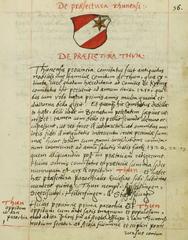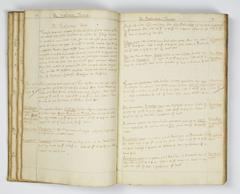Handwritten chorography
The Schöpfkarte was not a product of land surveying but emerged from the interrelationship with a handwritten description, the so-called chorography.
Until recently, only few manuscripts of the chorography were known.
During the preparation for this exhibition as well as for the accompanying journal issue, researchers discovered several more manuscripts as well as 15 additional topographies, which contain extracts from the chorography. The image on the left shows a page from the oldest known chorography and contains a description of Thun.
The small number of previous manuscripts allows for the conclusion that they were perceived as top-secret information carriers, which the powerful elite of the state of Bern tried to keep under lock and key leading up to the Thirty Years’ War. It was not until after 1650 that a wider distribution of the scripts indicates an alleviation of the secrecy. Nevertheless, the Schöpfkarte and the chorography did shape the mapping of Bern significantly for 150 years.
The manuscript on the right was discovered only recently in the Burgerarchiv Thun and contains a description of the city as well.


